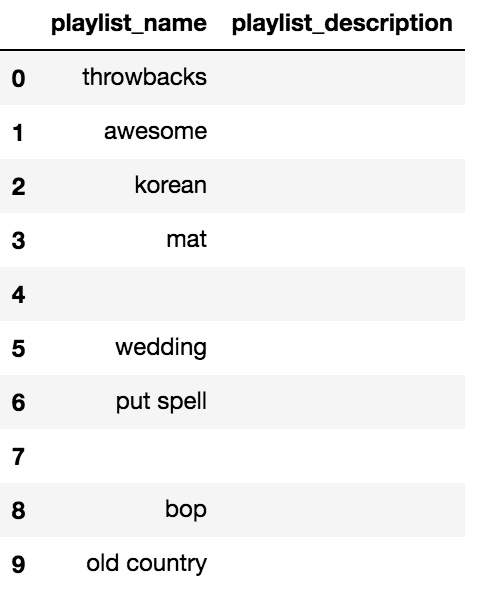Table of Contents
Project Statement and Goals
Motivation and Background
Data Description
EDA
Data Cleaning
Metrics
Model Training
Interpreting the Model
Model Testing and Results
Conclusion and What’s Next
Literature Review
Data Cleaning:
Loading the data
The MPD is organized into 100 separate JSON files where each file contain 1’000 playlists. In order to give us flexibility we first load the data into four distict data structures:
-
A list containing all the playlist
-
A dictionary with all the tracks
-
A list that maps songs to playlists
-
A list that maps duplicate songs to playlists
The fourth data structure was added after we conducted the EDA. During the EDA we found out that a playlist can contain duplicate songs. Although this may make sense for someone that is creating a playlist manually, we feel that it does not make sense for a suggestion engine. Suggesting something that has already been played feels like cheating. We put all the duplicates into the last data structure, that way we could see how many duplicates there were and easily exclude them from further processing.
playlists = list()
tracks = dict()
map_pl = list()
map_pl_duplicate = list()
max_files_for_quick_processing = 4
def process_track(track):
key = track['track_uri']
if not key in tracks:
tk = dict()
tk['track_artist_name'] = track['artist_name']
tk['track_artist_uri'] = track['artist_uri']
tk['track_name'] = track['track_name']
tk['track_album_uri'] = track['album_uri']
tk['track_duration_ms'] = track['duration_ms']
tk['track_album_name'] = track['album_name']
tk['track_pos'] = track['pos']
tracks[track['track_uri']] = tk
return key
def process_playlist(playlist):
pl = dict()
pl['playlist_name'] = playlist['name']
pl['playlist_collaborative'] = playlist['collaborative']
pl['playlist_pid'] = playlist['pid']
pl['playlist_modified_at'] = playlist['modified_at']
pl['playlist_num_albums'] = playlist['num_albums']
pl['playlist_num_tracks'] = playlist['num_tracks']
pl['playlist_num_followers'] = playlist['num_followers']
pl['playlist_num_edits'] = playlist['num_edits']
pl['playlist_duration_ms'] = playlist['duration_ms']
pl['playlist_num_artists'] = playlist['num_artists']
if 'description' in playlist:
pl['playlist_description'] = playlist['description']
else:
pl['playlist_description'] = ''
trks = set()
for track in playlist['tracks']:
if track['track_uri'] not in trks:
trks.add(track['track_uri'])
process_track(track)
map_pl.append([playlist['pid'], track['track_uri']])
else:
map_pl_duplicate.append([playlist['pid'], track['track_uri']])
return pl
def process_mpd(path):
count = 0
filenames = os.listdir(path)
for filename in sorted(filenames):
print(filename)
if filename.startswith("mpd.slice.") and filename.endswith(".json"):
fullpath = os.sep.join((path, filename))
f = open(fullpath)
js = f.read()
f.close()
slice = json.loads(js)
for playlist in slice['playlists']:
playlists.append(process_playlist(playlist))
count += 1
if quick and count > max_files_for_quick_processing:
break
quick = True
process_mpd('mpd.v1/data')
After loading up the entire dataset we have:
1’000’000 playlists
2’262’292 tracks
65’464’776 songs in the playlists
881’652 duplicate songs
Pandas
We now convert our three data structures to Pandas data frames:
playlist_df = pd.DataFrame(playlists)
tracks_df = pd.DataFrame.from_dict(tracks, orient='index')
playlist_map_df = pd.DataFrame(map_pl, columns=['playlist_pid', 'track_uri'])
The playlist dataframe
playlist_df.head()
playlist_df.tail()
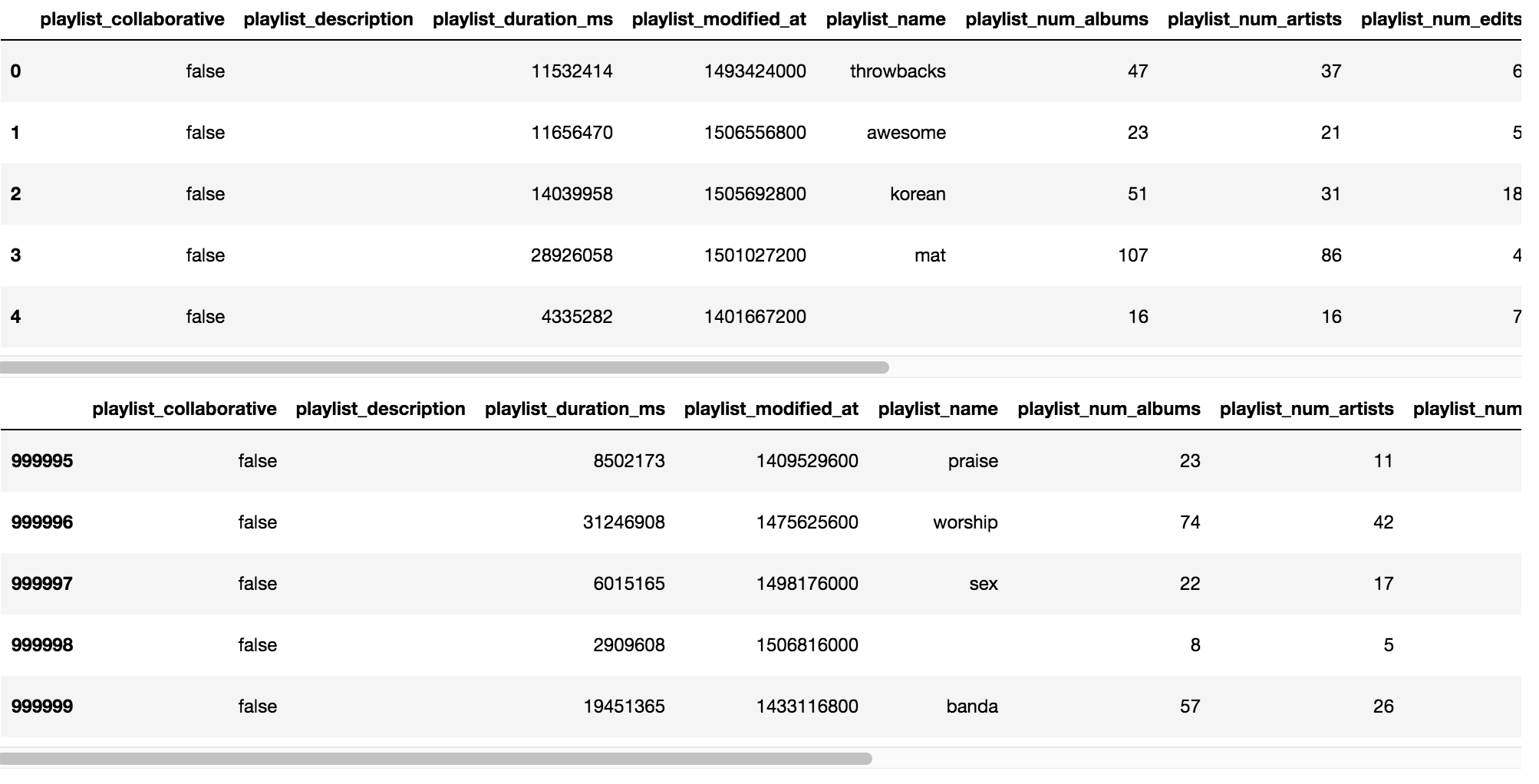
The tracks dataframe
tracks_df.head()
tracks_df.tail()
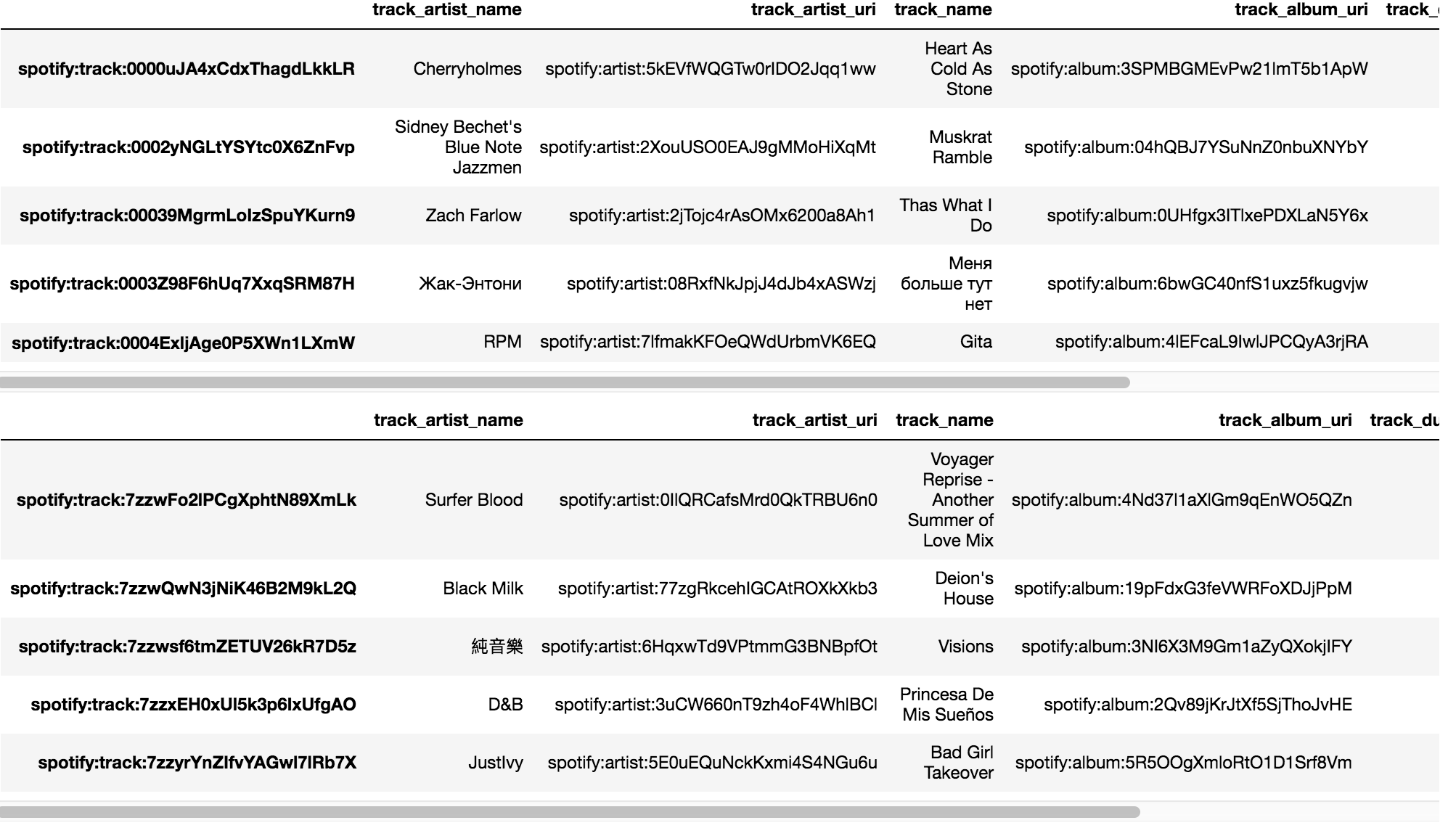
The playlist to song mapping dataframe
playlist_map_df.head()
playlist_map_df.tail()
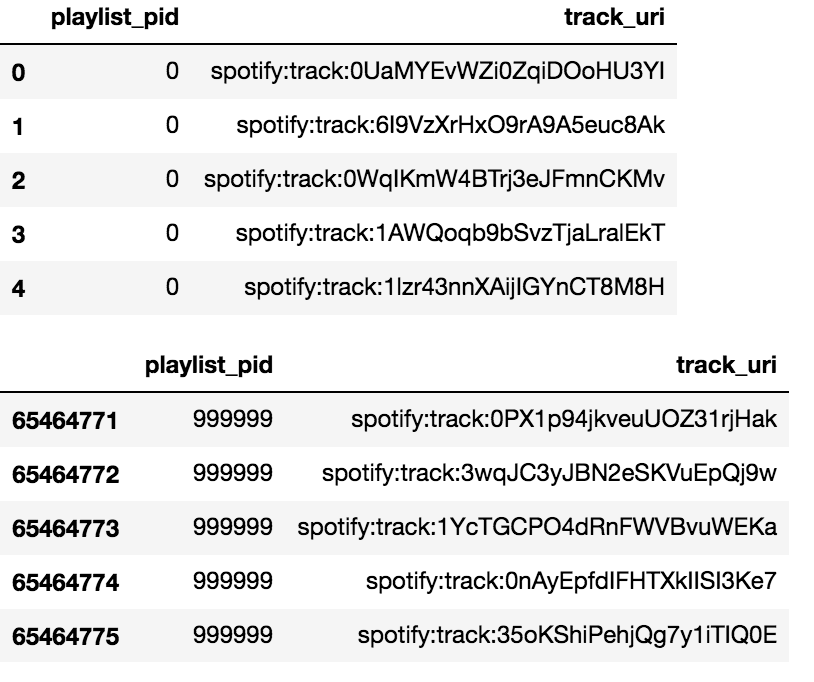
Negative Samples
Here we first refer to our response variable “Match” which will be frequently referenced in our reporting:
In order to train our model we also need a negative sample set. We will add random songs to each playlist. We add a binary value called match which is used as the response variable for the model.
We make a copy of the playlist to song mapping dataframe, we then randomly assign songs to playlist:
playlist_map_df_negative = playlist_map_df.copy()
random = playlist_map_df.sample(n=len(playlist_map_df)).reset_index()
playlist_map_df_negative['track_uri'] = random['track_uri']
We verify that the new dataset is indeed scrambled by checking heads:
playlist_map_df.head()
playlist_map_df_negative.head()
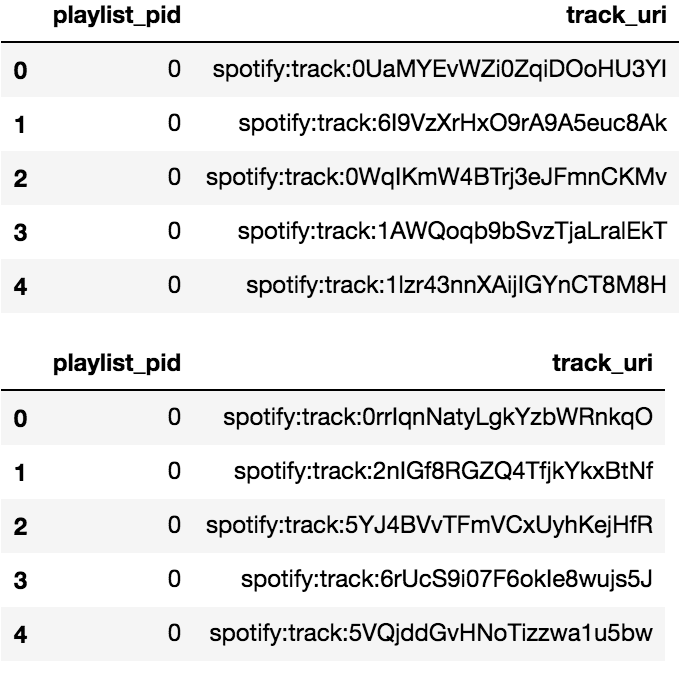
Denormalizing the data
We cannot effectively use multiple data frames for our modelling. we next need to merge the data frames together. We first merge the dataset with the original data into a single data frame:
merged = pd.merge(
pd.merge(
tracks_df, playlist_map_df, left_index=True, right_on='track_uri'),
playlist_df,
on='playlist_pid')
We also create a single dataframe of the scrambled (negative samples) data frame:
negative_samples = pd.merge(
pd.merge(
tracks_df, playlist_map_df_negative, left_index=True, right_on='track_uri'),
playlist_df,
on='playlist_pid')
We now have two dataframes both with the same playlist, but the negative samples playlist has randomized its song contents. Before merging the datasets together we add the binary response variable match. Each playlist will have a matching to not matching ratio of 1:1.
negative_samples['match'] = 0
merged['match'] = 1
We merge the two datasets together:
dataset = pd.concat([negative_samples, merged]).sort_values(by=['playlist_pid']).reset_index(drop=True)
Using playlist name and description as a proxy for song meta-data
As described in the Data Description we have chosen not to include the Million Song Dataset (MSD) as we believe we can extract meta-data on songs from the playlist name and the description. We show the the top 30 playlist names, all those playlists are single word playlists name and their names are indeed categorical like: rock, chill, country etc.
In order to ease the word vectorization we clean up the playlist names and the descriptions by removing stop words and we set everything to lowercase. We also remove the types of words we see often in playlist names like: “playlist”, “favorites”, “tunes”, “good, “mix” etc. We do not think these words add any value for categorizing the songs.
import nltk
import string
from nltk.corpus import stopwords
stop = stopwords.words('english')
ignored_words = [
'music', 'songs', 'playlist', 'good', 'jams', 'mix', 'lit', 'best',
'stuff', 'quot', 'like', 'one', 'amp', 'get', 'make', 'new', 'know',
'really', 'back', 'day', 'days', 'little', 'things', 'great', 'everything',
'jamz', 'tunes', 'artist', 'song', 'top', 'listen', 'favorite', 'bops',
'description', 'top', 'ever', 'mostly', 'enjoy', 'bunch', 'track',
'tracks', 'collection', 'need', 'every', 'favorites', 'may', 'got',
'right', 'let', 'better', 'made'
]
def word_cleanup(df_col):
df_col = df_col.apply(lambda x: x.lower())
df_col = df_col.str.replace('[^a-z]+', ' ')
df_col = df_col.apply(lambda x: ' '.join([word for word in x.split() if word not in (stop)]))
df_col = df_col.apply(lambda x: ' '.join([word for word in x.split() if word not in (ignored_words)]))
df_col = df_col.str.replace(r'\b\w{1,2}\b', '').str.replace(r'\s+', ' ')
return df_col
playlist_df.playlist_description = word_cleanup(playlist_df.playlist_description)
playlist_df.playlist_name = word_cleanup(playlist_df.playlist_name)
Only 1.9% of playlists have descriptions so when listing the first 10 playlists all descriptions are empty.
First 10 playlist names and descriptions before clean up
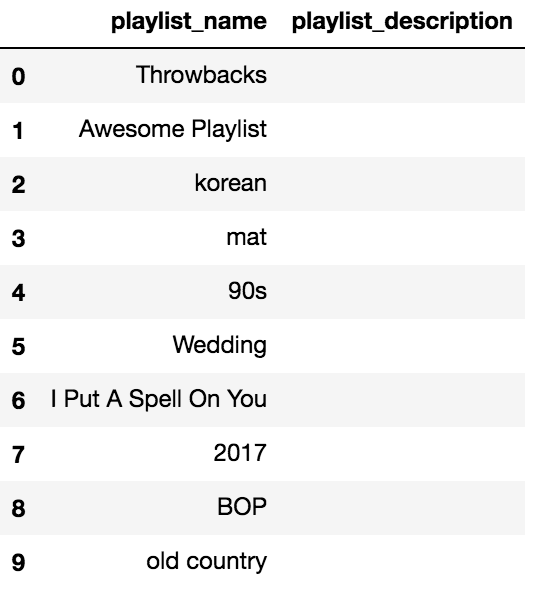
First 10 playlist names and descriptions after clean up
